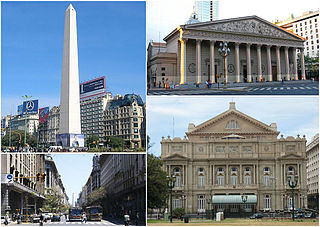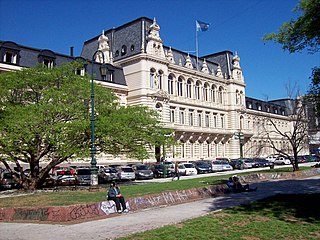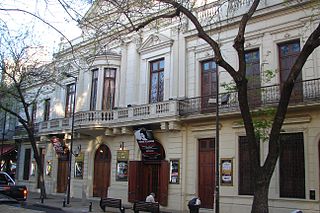
The Teatro Colón is the main opera house in Buenos Aires, Argentina. It is considered one of the ten best opera houses in the world by National Geographic. According to a survey carried out by the acoustics expert Leo Beranek among leading international opera and orchestra directors, the Teatro Colón has the room with the best acoustics for opera and the second best for concerts in the world.

San Nicolás is one of the neighbourhoods of Buenos Aires, Argentina, sharing most of the city and national government Neighborhood of Buenos Aires with neighboring Montserrat and home to much of the financial sector. It's referred usually as El Centro, and the part east of the 9 de Julio Avenue is known as Microcentro.

Avenida Corrientes is one of the principal thoroughfares of the Argentine capital of Buenos Aires. The street is intimately tied to the tango and the porteño sense of identity. Like the parallel avenues Santa Fe, Córdoba, and San Juan, it takes its name from one of the Provinces of Argentina.

Colegiales is a barrio or district in Buenos Aires, Argentina. It is located between Alvarez Thomas av., Forest av., De los Incas av., Virrey del Pino st., Cabildo av., Jorge Newbery st., Crámer st. and Dorrego av. This neighborhood offers a vast amount of contrast and opportunities.

Enrique Telémaco Susini was an Argentine entrepreneur and media pioneer.
Created by Enrique Telémaco Susini, LOR Radio Argentina was the first national broadcast radio station in Argentina. It operated continuously from 1920 to 1997.

The Teatro Argentino de La Plata is the second most important lyric opera house in Argentina, after the Teatro Colón in Buenos Aires. The theatre is located in a central block of the city of La Plata, the capital of Buenos Aires Province. The venue occupies the block bounded by the 9 and 10 streets and 51 & 53 avenues; it belongs to the Monumental Axis of public buildings in La Plata.

The Teatro Gran Rex is an Art Deco style theatre in Buenos Aires, Argentina which opened on July 8, 1937, as the largest cinema in Argentina.

The Teatro Nacional Cervantes in Buenos Aires is the national stage and comedy theatre of Argentina.

The Avenida Theatre is a theatre in Buenos Aires, Argentina.

The Teatro Opera is a prominent cinema and theatre house in Buenos Aires, Argentina.

The Sarmiento Palace, commonly known as the Pizzurno Palace, is an architectural landmark in the Recoleta section of Buenos Aires and the location of the Argentine Ministry of Education.

Paseo La Plaza is a cultural and commercial complex in the San Nicolás section of Buenos Aires, Argentina.

Patio Bullrich is an important shopping center in the Retiro section of Buenos Aires.

The Teatro General San Martín is an important public theater in Buenos Aires, located on Corrientes Avenue and adjacent to the cultural center of the same name. It is one of the major theaters in Argentina and offers venues for the representation of stage works and film, as well as art exhibitions.

Punto Obelisco is a zone around the Obelisk of Buenos Aires and the Plaza de la República. It is a project held by the city's government in order to enrich the surroundings of the monument and to make it the center of entertainment in the city. A zone combining the theatres avenue and the lights of LED signs taking inspiration from Times Square in New York City, the Shibuya Crossing in Tokyo and Piccadilly Circus in London and runs through Avenida 9 de Julio between Rivadavia Avenue and Córdoba Avenue. It also includes a ticket sales stand.

Buenos Aires is one of the world's capitals of theatre. The Teatro Colón is a national landmark for opera and classical performances; built at the end of the 19th century, its acoustics are considered the best in the world, and has undergone a major refurbishment in order to preserve its outstanding sound characteristics, the French-romantic style, the Golden Room, and the museum at the entrance. With its theatre scene of national and international caliber, Corrientes Avenue is synonymous with the art. It is thought of as the street that never sleeps, and sometimes referred to as the Broadway of Buenos Aires. Many careers in acting, music, and film have begun in its many theaters. The Teatro General San Martín is one of the most prestigious, along Corrientes Avenue, and the Teatro Nacional Cervantes functions as the national stage theater of Argentina. The Teatro Argentino de La Plata, El Círculo in Rosario, Independencia in Mendoza, and Libertador in Córdoba are also prominent. Griselda Gambaro, Copi, Roberto Cossa, Marco Denevi, Carlos Gorostiza, Alberto Vaccarezza and Mauricio Kartun are a few of the more prominent Argentine playwrights. Julio Bocca, Jorge Donn, José Neglia, and Norma Fontenla are some of the great ballet dancers of the modern era.
This is a timeline of the history of the city of Buenos Aires, Argentina.

The Teatro Municipal Coliseo Podestá is a 1,065-seat auditorium located on the streets 46 and 47, avenue 10 (#733), City of La Plata, capital of the Buenos Aires Province, en Argentina.

Teatro de la Victoria was one of the main theaters in the city of Buenos Aires around the middle of the 19th century. It was one of the most modern and luxurious of its time, built by an Italian architect who also had carried out the works of the Parroquia Nuestra Señora de Balvanera.






















